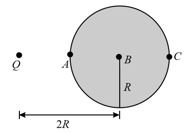EASY
CUET (UG)
IMPORTANT
Earn 100
Assertion: Electric field inside the metal is zero when it is placed in external electric field.
Reason: In metal, induced electric field is equal and opposite of applied field.
(a)If both Assertion and Reason are true and the Reason is correct explanation of the Assertion.
(b)If both Assertion and Reason are true but Reason is not correct explanation of the Assertion.
(c)If Assertion is true but the Reason is false.
(d)If Assertion is false but Reason is true.
100% studentsanswered this correctly

Important Questions on Electrostatic Potential and Capacitance
EASY
CUET (UG)
IMPORTANT
Assertion: The whole charge of a conductor cannot be transferred to another isolated conductor.
Reason: The total transfer of charge from one to another is not possible.
EASY
CUET (UG)
IMPORTANT
In the following a statement of Assertion is followed by a statement of Reason.
Assertion: Charged metallic surface in electrostatic condition is always an equipotential surface.
Reason: There is no component of electric field (in electrostatic condition) parallel to charged metallic surface.
EASY
CUET (UG)
IMPORTANT
A point charge is placed at a distance from centre of an uncharged metallic sphere of radius , select the correct alternative

EASY
CUET (UG)
IMPORTANT
Out of two copper spheres of the same size, is hollow while is solid. If they are charged at the same potential, what can be said about the charges on them?
EASY
CUET (UG)
IMPORTANT
A solid conductor is placed in an uniform electric field as shown in figure. Which path will the lines of force follow?
EASY
CUET (UG)
IMPORTANT
An astronaut is in an all-metal chamber outside the space station when a solar storm results in the deposit of a large positive charge on the station. Which statement is correct?
EASY
CUET (UG)
IMPORTANT
An uncharged sphere of metal is placed inside a charged parallel plate capacitor. The electric lines of force will look like
EASY
CUET (UG)
IMPORTANT
What is the ratio of the electrostatic potentials at one corner and in the centre point of a uniformly charged cube of the conductor? (The potential is considered at infinity)
